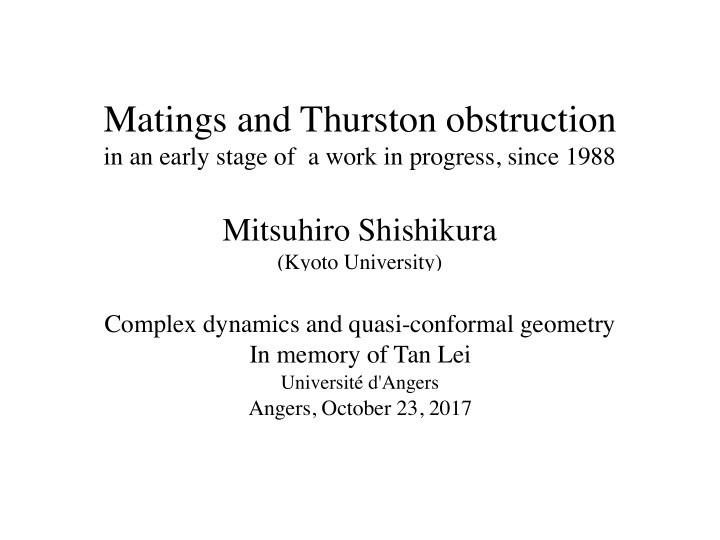



Matings and Thurston obstruction in an early stage of a work in progress, since 1988 Mitsuhiro Shishikura (Kyoto University) Complex dynamics and quasi-conformal geometry In memory of Tan Lei Université d'Angers Angers, October 23, 2017
Tan Lei (1963-2016) Matings of polynomials Douady's Bourbaki seminar 1983 Thurston's theorem, Thurston 1983, Douady-Hubbard1993 Mary Rees, 1995 Proc. LMS Unpublished manuscript 1986, Realization of matings of polynomials as rational maps of degree two Tan Lei, 1986, C. R. Acad. Sci., Accouplements des polynômes quadratiques complexes 1992, Erg. Th. & Dynam. Sys. Matings of quadratic polynomilas In 1986, I met Douady and Tan Lei in Paris S. - Tan Lei, Max Planck Institute Preprint 1988, published 2000 Tan Lei, Cubic Newton's method, 1997 S. On a theorem of M. Rees for the matings of polynomials , in "The Mandelbrot set, Theme and Variations", Ed. Tan Lei, 2000
Matings of polynomials Rational maps are more difficult than polynomials. Try to understand the dynamics of a rational maps via a pair of polynomials Douady's Bourbaki seminar 1982/1983 topological mating Thurston's theorem, Thurston 1983, Douady-Hubbard1993 definition of Thurston equivalence for pcf branched coverings Formal mating (modified formal mating after removing degenerate obstructions) Q1. Is a (pcf) formal mating Thurston equivalent to a rational map? Q2. If so, is it the same as the topological mating?
Thurston's theorem on the characterization of rational maps among self-branched covering of 2-sphere.
Thurston matrix
In this talk, we focus on the mateability question (Thurston eq to a rat map?) Q1. Is a (pcf) formal mating Thurston equivalent to a rational map? A key ingredient is Levy cycle theorem. Levy cycle theorem allows us to derive a combinatorial condition from the topological (up to isotopy) one.
Q. (Tan Lei 1988) Does the Levy cycle theorem hold for higher degree rational maps? Or for the formal matings? NO: A cubic example (S. and Tan Lei) It was not first constructed as a mating, but from a tree of obstruction. z x y
Tree associated to an invariant multicurve of a PCF map Given a multicurve Γ on S 2 , one can associate a tree T = T Γ so that each connected component of S 2 � ∪ Γ corresponds to a vertex of T ; each γ corresponds to an edge of T which connects the two vertices corresponding to components of S 2 � ∪ Γ sharing γ as boundary. ("dual graph") cf. Work by Pilgrim
Mechanism for quadratic Levy cycle theorem This argument fails as soon as there are 3 critical points. 1 2 z x y Realize it as a branched cover 3 and later as a mating
Q. How can we detect the obstruction of a PCF branched covering maps? How about in the case of the matings of polynomials? Partial answers: S.-Tan Lei, Tan Lei, Pilgrim-Tan Lei, etc. difficulties in the infinite conditions in Thurston's theorem. Positive criterion by Dylan Thurston. Q. In the cubic example, is it a coincidence that the tree of obstruction looks similar to the Hubbard trees? NO. We looked for the polynomials whose Hubbard tree is like . Q. How general is this phenomenon and how to use it in order to detect possible obstructions? "In progress" since 1988: we want to say something like:
We propose as a tentative definition of "factor" as follows: example: mating of Chebyshev map and real quadratic map Related to: Milnor-Thurston kneading theory on unimodal maps (allowable sequences) Milnor: model for real cubic maps "stunted sawtooth map" Thurston: core entropy, monotonicity along veins of M
Possible application?
A Scenario for the construction of the "factor map" h This is far from canonical, because one can move the intersection by homotopy.
Merci!
Recommend
More recommend